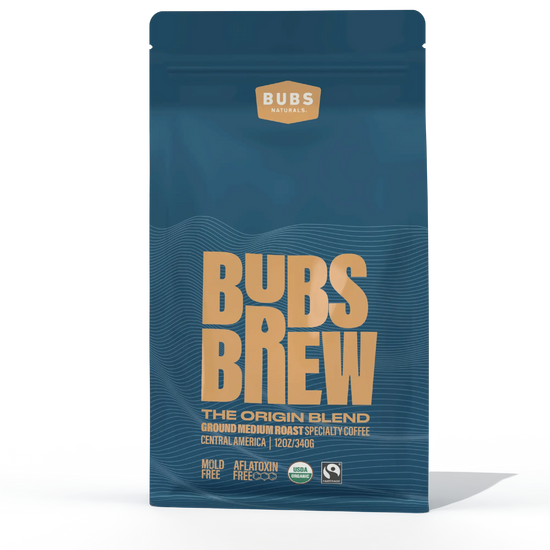Table of Contents
- Introduction
- Understanding Mycotoxins and Their Sources
- The Impact of Mycotoxins on Health
- How to Identify Mold-Free Coffee Brands
- Practical Tips for Coffee Storage and Preparation
- Conclusion
- FAQ
Introduction
Did you know that over 90% of commercial coffee is potentially contaminated with mycotoxins, harmful compounds produced by certain molds? This alarming statistic raises important questions about the coffee we consume daily. For many of us, coffee is not just a beverage but an essential part of our morning routine and daily rituals. So, how can we ensure that the coffee we enjoy is clean, safe, and free from harmful substances?
In this blog post, we will explore the world of mold-free coffee, shedding light on what mycotoxins are, how they can affect our health, and most importantly, how to find high-quality coffee that is free from these contaminants. With our commitment to wellness and quality at BUBS Naturals, we are here to guide you through the process of selecting coffee that not only tastes great but also supports your overall health and wellbeing.
We will cover the following key areas:
- Understanding mycotoxins and their sources
- The impact of mycotoxins on health
- How to identify mold-free coffee brands
- Certifications and quality indicators to look for
- Practical tips for coffee storage and preparation
By the end of this post, you’ll have a well-rounded understanding of how to choose mold-free coffee and can confidently elevate your coffee-drinking experience.
Understanding Mycotoxins and Their Sources
Mycotoxins are toxic compounds produced by certain molds that can grow on various crops, including coffee. Understanding where these toxins come from is crucial in our quest for safe coffee.
How Mycotoxins Form
Mycotoxins can develop during the growth, harvest, storage, and transportation of coffee beans. Factors such as humidity, temperature, and poor storage conditions create a perfect environment for mold growth. Low-quality coffee often comes from poorly managed farms where beans may be harvested at suboptimal times, leading to an increased risk of mold contamination.
Common Types of Mycotoxins in Coffee
The two most prevalent mycotoxins found in coffee are aflatoxins and ochratoxin A. These substances have been linked to various health concerns, which we will discuss in the next section.
Factors Leading to Mycotoxin Presence
- Poor Farming Practices: Low-quality coffee often comes from farms that do not prioritize quality or proper harvesting techniques, leading to moldy beans.
- Improper Storage: Coffee beans stored in damp or humid conditions are more susceptible to mold growth.
- Transport Conditions: The journey from farm to cup can expose beans to various environmental factors that encourage mold.
By understanding these factors, we can take proactive steps to select coffee that is less likely to contain mycotoxins.
The Impact of Mycotoxins on Health
While many people consume coffee regularly without immediate adverse effects, mycotoxins can pose long-term health risks.
Health Effects of Mycotoxins
-
Short-Term Symptoms: Some individuals may experience nausea, headaches, or gastrointestinal issues after consuming contaminated coffee.
-
Long-Term Risks: Prolonged exposure to mycotoxins has been linked to more severe health issues, including immune system suppression and potential carcinogenic effects.
-
Sensitive Populations: Those with mold sensitivities, pregnant women, and individuals with pre-existing health conditions may be at a higher risk for adverse effects.
At BUBS Naturals, we believe in maintaining a healthy lifestyle that supports both physical and mental wellbeing. Understanding the risks associated with mycotoxins is a vital part of that commitment.
How to Identify Mold-Free Coffee Brands
Finding coffee that is free from mold can feel daunting, but it doesn’t have to be. Here are some practical tips for identifying trustworthy brands:
Look for Specialty Coffee
Specialty-grade coffee is meticulously sourced and evaluated for quality. To be classified as specialty coffee, beans must score 80 or higher on a 100-point scale set by certified Q Graders. Specialty coffee is less likely to contain mycotoxins due to the rigorous quality control processes in place.
Check for Certifications
Certifications can help you identify high-quality coffee. Look for:
- USDA Organic: Indicates that the coffee is grown without harmful pesticides.
- Third-Party Tested: Brands that provide lab testing results for mycotoxins show transparency and commitment to quality.
- Biodynamic Certification: This goes beyond organic, ensuring that farming practices are holistic and sustainable.
Research Brand Practices
Investigate the sourcing and processing practices of the brands you are considering. Brands that prioritize quality will likely provide information about their coffee's origin, processing methods, and testing practices.
Practical Tips for Coffee Storage and Preparation
Even when you purchase high-quality, mold-free coffee, how you store and prepare it can also affect its quality. Here are some tips to keep in mind:
Proper Storage
- Airtight Containers: Store your coffee beans in airtight containers to keep moisture and air out.
- Avoid Refrigeration: Do not store coffee in the fridge or freezer, as humidity can lead to mold growth.
- Cool, Dark Place: Keep your coffee in a cool, dark place to maintain freshness.
Brewing Practices
- Clean Equipment: Regularly clean your coffee maker to avoid mold growth in your brewing equipment.
- Brew Fresh: Brew only what you need to avoid storing brewed coffee, which can encourage mold growth.
By following these guidelines, you can enhance the longevity and quality of your coffee.
Conclusion
The journey to finding mold-free coffee may seem challenging, but with the right knowledge and tools, you can make informed choices that contribute to your health and wellbeing. At BUBS Naturals, we stand by our commitment to quality, wellness, and supporting veteran-focused charities through our products.
As you explore the world of specialty coffee, remember to look for high-quality sources, check for certifications, and practice proper storage and brewing techniques. By doing so, you can confidently enjoy your cup of coffee, knowing that it aligns with your wellness goals.
FAQ
Q: What are mycotoxins?
A: Mycotoxins are toxic compounds produced by certain molds that can grow on various crops, including coffee. They can pose health risks when ingested.
Q: How can I ensure my coffee is mold-free?
A: Look for specialty-grade coffee, check for certifications like USDA Organic or third-party testing, and research the sourcing and processing practices of the brands you choose.
Q: Are all coffee brands at risk for mycotoxin contamination?
A: While many commercial coffee brands may be at risk due to poor farming and storage practices, specialty coffee brands often have stricter quality controls to minimize this risk.
Q: What are the health effects of consuming mycotoxins?
A: Short-term effects may include nausea and gastrointestinal issues, while long-term exposure can lead to more severe health risks, including immune system suppression.
Q: How should I store my coffee to prevent mold?
A: Store coffee beans in airtight containers in a cool, dark place, and avoid refrigeration to maintain freshness and prevent mold growth.
For those looking to elevate their coffee experience, we invite you to explore our BUBS Brew Coffee collection to enjoy a clean, mycotoxin-free cup. Together, let’s support our wellness journeys while honoring the legacy of Glen “BUB” Doherty.
Written by:
Bubs Naturals

Origin Blend Coffee | Medium Roast
Starts at $17.95
Shop

